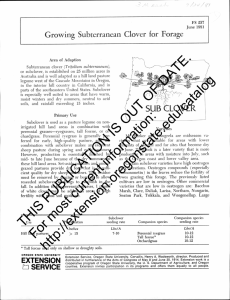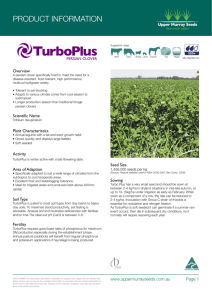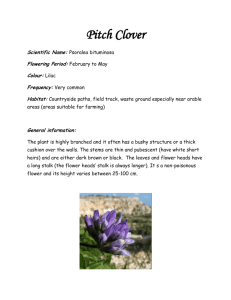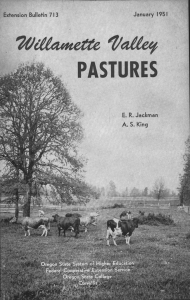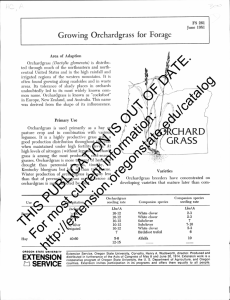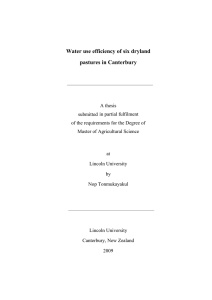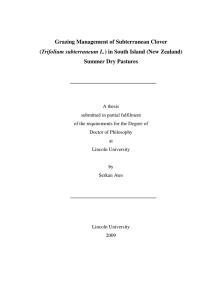Growing White Clover for Forage
advertisement
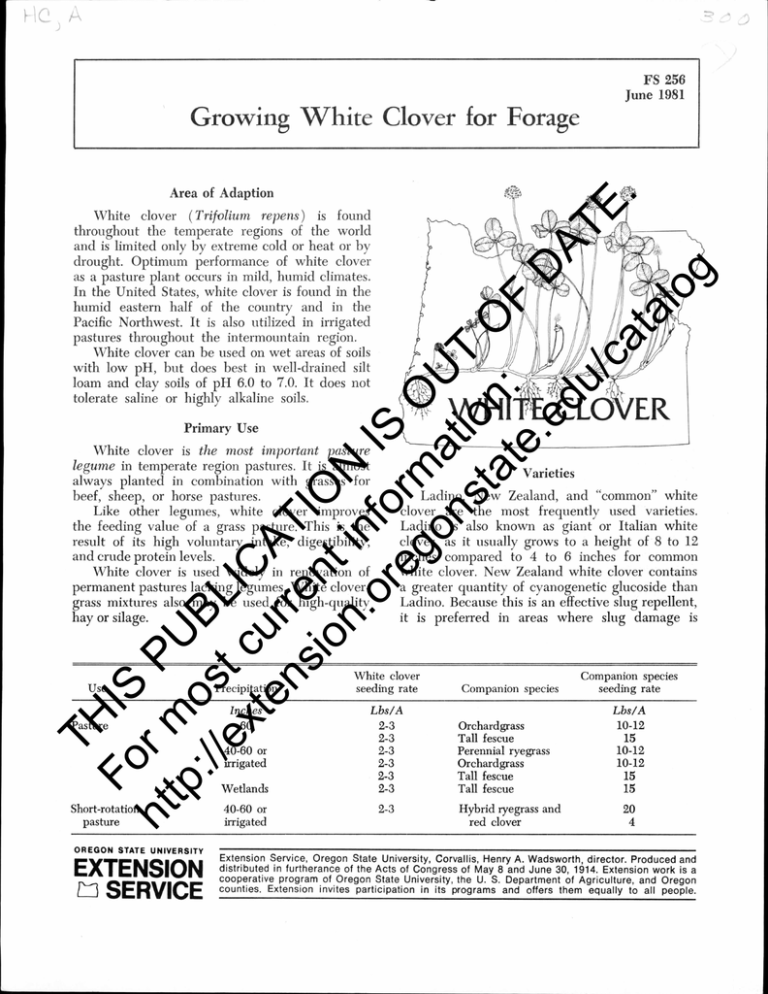
FS 256 June 1981 \ Growing White Clover for Forage Fo IS ht r m P U tp :// os BL ex t c IC te ur A ns re TI io nt ON n. in or fo IS eg rm O on at U st ion T O at : F e. D ed A u/ TE ca . ta lo g Area of Adaption White clover (Trifolium repens) is found throughout the temperate regions of the world and is limited only by extreme cold or heat or by drought. Optimum performance of white clover as a pasture plant occurs in mild, humid climates. In the United States, white clover is found in the humid eastern half of the country and in the Pacific Northwest. It is also utilized in irrigated pastures throughout the intermountain region. White clover can be used on wet areas of soils with low pH, but does best in well-drained silt loam and clay soils of pH 6.0 to 7.0. It does not tolerate saline or highly alkaline soils. Primary Use White clover is the most important pasture legume in temperate region pastures. It is almost always planted in combination with grasses for beef, sheep, or horse pastures. Varieties Ladino, New Zealand, and "common" white clover are the most frequently used varieties. Ladino is also known as giant or Italian white Like other legumes, white clover improves the feeding value of a grass pasture. This is the result of its high voluntary intake, digestibility, clover, as it usually grows to a height of .8 to 12 inches compared to 4 to 6 inches for common and crude protein levels. White clover is used widely in renovation of grass mixtures also may be used for high-quality white clover. New Zealand white clover contains a greater quantity of cyanogenetiC glucoside than Ladino. Because this is an effective slug repellent, hay or silage. it is preferred in areas where slug damage is permanent pastures lacking legumes. White clover- TH Use Pasture Precipitation Inches 60 40-60 or irrigated Wetlands Short-rotation pasture OREGON STATE UNIVERSITY EXTENSION PI SERVICE 40-60 or irrigated White clover seeding rate Lbs/ A 2-3 2-3 2-3 2-3 2-3 2-3 2-3 Companion species Orchardgrass Tall fescue Perennial ryegrass Orchardgrass Tall fescue Tall fescue Hybrid ryegrass and red clover Companion species seeding rate Lbs/ A 10-12 15 10-12 10-12 15 15 20 4 Extension Service, Oregon State University, Corvallis, Henry A. Wadsworth, director. Produced and distributed in furtherance of the Acts of Congress of May 8 and June 30, 1914. Extension work is a cooperative program of Oregon State University, the U. S. Department of Agriculture, and Oregon counties. Extension invites participation in its programs and offers them equally to all people. common. The glucoside is not present in sufficient quantity to affect most livestock, but it may cause photosensitization in horses. Common white Management The most difficult problem in managing white clover-grass pastures is maintaining the clover. winter hardiness, but they are not usually as productive as New Zealand or Ladino white clover. Frequent defoliation during the period of maximum grass growth ( early spring) encourages white clover by minimizing grass competition. Mixed pastures should be used before the grass reaches its maximum competition. Clipping or clovers are small, prostrate clovers with good Establishment harvesting surplus forage in understocked pastures Fo IS ht r m P U tp o :// s BL ex t c IC te ur A ns re TI io nt ON n. in or fo IS eg rm O on at U st ion T O at : F e. D ed A u/ TE ca . ta lo g Soil preparation should provide a fine, firm, weed-free seedbed. Fall plowing followed by light working of the surface soil in the spring will produce an excellent seedbed. Spring seeding should be done early to allow 4 to 6 weeks of growth before the dry season arrives. A similar time should be allowed before the first freeze if seed is sown in late summer. Under irrigated conditions, timing will help maintain the clover and control the deeper than 3i inch immediately following innoculation with the proper Rhizobium. Firming the soil following planting will aid in rapid establishment of the seedlings. pasture renovation. Bloat is often a problem for animals on pastures is not as critical. Seed should be planted no Fertility and pH Requirements Liming to achieve a pH of 6.0 or using limepelleted seed is recommended. Adequate levels of potassium, phosphorus, and sulfur should be available, as white clover requires a high level of fertility for high production. Properly inoculated and nodulated white clover-grass pastures will not require the addition of nitrogen. Early spring ap- plication of small amounts of nitrogen If pastures are grazed continuously, the height of forage should be maintained at 2 to 6 inches, depending on the grass species. Fall management should allow adequate regrowth for rooting new stolons before the first freeze. Disappearance of white clover from pastures can be remedied by that contain a large proportion of white clover. Methods of controlling bloat in mixed clover-grass pastures include supplementing pastures with grass hay and intensive strip grazing. Bloatpreventative materials, which prevent rumen foam production, may be added to drinking water, applied as a top dressing on grain supplements, or added to salt-molasses blocks. The effectiveness of these methods depends upon animals obtaining a regular supply of bloat preventative. ( 30-40 lbs.) will stimulate early growth of grass but will favor the grass over the legume. For specific fertilizer recommendations based on soil test data, consult OSU Fertilizer Guides 1, 21, and 58. TH grass and weeds. By David B. Hannaway, Extension agronomist, and William S. McGuire, professor of agronomy, Oregon State University.
